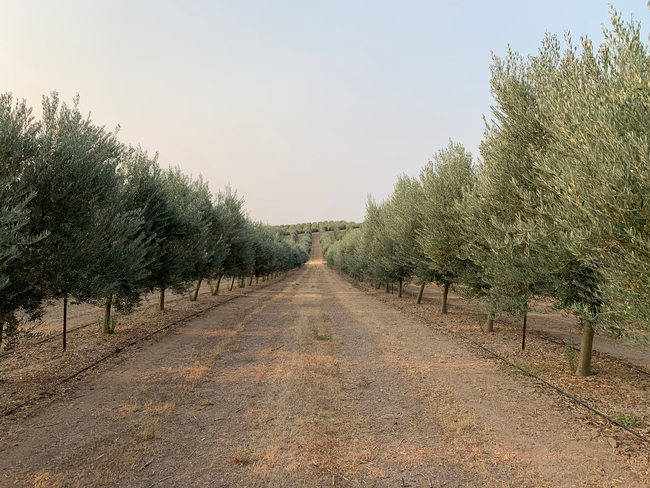
Ferguson co-edits first-ever manual on growing olives for oil
Growers, researchers offer guidance for beating global competition

Facing a deluge of lower-priced products from Europe, California olive oil producers are doubling down on their clear competitive edge: true and consistent quality.
“Olive: Production Manual for Oil” is a new book that aims to help California olive growers maximize that advantage. It has just been published by University of California Agriculture and Natural Resources.
Louise Ferguson, a professor in the UC Davis Department of Plant Sciences, is a tree fruit and nut expert with UC Cooperative Extension and co-editor of the volume.
“Most of the information is data-based, from people who are working with the olives,” Ferguson said. “This is the first data-based olive oil production manual we've had.”
“It's a tough market to compete in, but the way to win for California is to compete on quality,” added co-editor Selina Wang, an Extension specialist in the Department of Food Science and Technology. “The quality of California olive oil is unmatched, but you can't make good quality olive oil with bad fruit, so the goal is to get more fruit from the trees – and for the fruits to be high-quality fruit.”
The 273-page manual is available for purchase online, and it’s the first of its kind in the U.S. While some parts of the book are specific to California (which grows nearly all of the olives for domestically produced olive oil), most of the material would be useful to producers in other states, Wang noted.
“Through our conversations with growers, it became clear to us that a manual like this – not a scientific publication but a manual that is easy to follow, written in language that is accessible, and with pictures and illustrations – would be really helpful to the growers,” Wang said.

Manual flows from growth in state’s olive oil industry
Until now, there has been no single, comprehensive resource for oil olive growers. The need for such a manual had become more acute as oil olives replaced table olives in California orchards during the last 20 years.
In the past, harvesting oil olives by hand was cost-prohibitive, but in 1999, the introduction of super-high-density planting systems made oil olive production more economically feasible. Mechanical pruning and harvesting of new cultivars (Arbequina, Arbosana and Koroneiki) – specifically bred for these densely planted orchards – led to the rapid expansion of oil olives in the state. California olive oil production jumped from 2 million pounds in 2006 to an average of 21 million pounds in 2021–23, according to a U.S. Department of Agriculture report.
With about 37,000 acres of oil olives planted across the state, the Olive Oil Commission of California saw the need to support the production of this manual. Wang and Ferguson outlined the contents of the book, championed by Dan Flynn, founder and executive director emeritus of the UC Davis Olive Center. Then, they sought out a mix of growers, industry professionals, and UCCE advisors and specialists to write its chapters.
Firsthand insights, practical recommendations

Through the book, growers convey a valuable lesson learned through hard experience: the need to prune by hand. While mechanical pruning helps control the size of the trees, some hand-pruning still is required to allow light to filter to the leaves. Failing to do so leads to a dramatic decrease in yield.
“That happened in many of the orchards (where managers) were inexperienced in these new cultivars and new, super-high-density planting systems,” Ferguson said.
Other key topics in the manual include irrigation management where water is scanty, nitrogen management, harvest timing and orchard site selection. Choosing a good spot for planting is crucial in this era of extreme climate volatility, Ferguson noted, as olive trees are significantly affected by temperature shocks in spring, when the fruit sets, and in fall, when fruit is harvested.
Another overarching theme in the manual is the importance of testing, Wang noted. Testing the soil, water and leaves provides critical data that growers can use to adjust their inputs and production practices for optimal profitability.
“You may spend a couple hundred dollars on the lab work, but it will pay off, for sure. You're going to increase the health and productivity of your trees,” Wang explained. “Oil olive growers are paid based on the oil content in their fruit. You not only want to have a lot of fruit on the trees, you want to make sure that your fruit are accumulating oil.”
Practices continue to evolve
Ferguson and Wang hope their book will help California growers compete more effectively in the global marketplace. Currently, about 90 percent of the olive oil consumed in the United States is imported from Mediterranean countries, due primarily to the lower prices. In that region, producers tend to harvest riper olives that produce oil at a greater volume, but lesser quality.
In contrast, California growers harvest earlier in the growing process and produce oil with more flavor and more antioxidants. That quality far exceeds accepted standards for “extra virgin olive oil.”
California olive oil mills have nearly maximized their efficiency, so opportunity for new growth in the industry lies in the orchards: produce more fruit and plant more trees. The new manual can help on both fronts.
“Just like for other crops, focusing on quality – while increasing efficiency and productivity, and therefore profitability – is the name of the game,” Wang said.
In addition, knowledge continues to evolve. Ferguson urged growers to reach out to the editors and chapter authors with their experiences.
“Most of the authors are in California, and they're working,” Ferguson said. “So if you start to notice things that are different, or you want more information, or something is not clear, the authors are available.”
Get your copy
You can buy “Olive: Production Manual for Oil” on the UC ANR website.
Media Resources
Michael Hsu is senior public Information representative for University of California Agricultural and Natural Resources.
